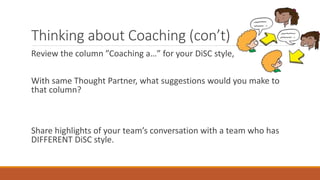The document provides information about a DISC assessment for leaders. It begins with welcome norms for the assessment and then provides several activities to help participants understand their behavioral tendencies. These include selecting a penny from a given year and sharing about that year, collecting signatures from others on a behavioral checklist, and learning about the DiSC model of human behavior. The document outlines the four main styles of the DiSC model - Dominance, Influence, Steadiness, and Conscientiousness. It also provides guidance for participants on completing their personal DISC profile and understanding their results.



















































































